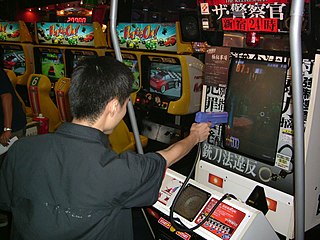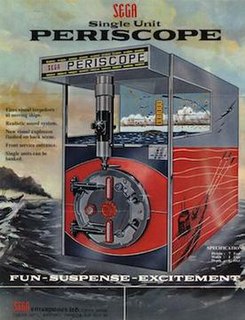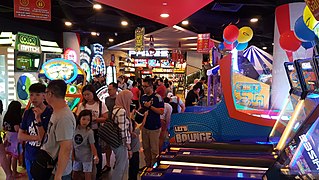Related Research Articles
A thief is a person who takes another person's property or services without consent.

An arcade video game takes player input from its controls, processes it through electrical or computerized components, and displays output to an electronic monitor or similar display. Most arcade video games are coin-operated, housed in an arcade cabinet, and located in amusement arcades alongside other kinds of arcade games. Until the late 1990s, arcade video games were the largest and most technologically advanced segment of the video game industry.

Space Invaders is a 1978 shoot 'em up arcade game developed by Tomohiro Nishikado. It was manufactured and sold by Taito in Japan, and licensed by the Midway division of Bally for overseas distribution. Space Invaders was the first fixed shooter and set the template for the shoot 'em up genre. The goal is to defeat wave after wave of descending aliens with a horizontally moving laser to earn as many points as possible.

An amusement arcade is a venue where people play arcade games, including arcade video games, pinball machines, electro-mechanical games, redemption games, merchandisers, or coin-operated billiards or air hockey tables. In some countries, some types of arcades are also legally permitted to provide gambling machines such as slot machines or pachinko machines. Games are usually housed in cabinets. The term used for ancestors of these venues in the beginning of the 20th century was penny arcades.
Thief is a 1981 arcade video game that is extremely similar to Pac-Man.
Stern is the name of two different but related arcade gaming companies. Stern Electronics, Inc. manufactured arcade video games and pinball machines from 1977–1985, and was known for 1980s Berzerk. Stern Pinball, Inc., founded in 1999, is a creator of pinball machines in North America.
The golden age of arcade video games was the period of rapid growth, technological development and cultural influence of arcade video games, from the late 1970s to the early 1980s. The period began with the release of Space Invaders in 1978, which led to a wave of shoot 'em up games such as Galaxian and the vector graphics-based Asteroids in 1979, made possible by new computing technology that had greater power and lower costs. Arcade video games transitioned from black-and-white to color, with titles such as Frogger and Centipede taking advantage of the visual opportunities of bright palettes.

Cinematronics Incorporated was an arcade game developer that primarily released vector graphics games in the late 1970s and early 1980s. While other companies released games based on raster displays, early in their history, Cinematronics and Atari, Inc. released vector-display games, which offered a distinctive look and a greater graphic capability, at the cost of being only black and white (initially). Cinematronics also published Dragon's Lair in 1983, the first major LaserDisc video game.
An electronic game is a game that uses electronics to create an interactive system with which a player can play. Video games are the most common form today, and for this reason the two terms are often used interchangeably. There are other common forms of electronic game including handheld electronic games, standalone systems, and exclusively non-visual products.

Sea Wolf is a shooter video game manufactured by Midway, originally released for arcades in 1976. It is a video game update of an earlier coin-operated electro-mechanical Midway game, Sea Devil, itself based on Sega's 1966 coin-op electro-mechanical arcade submarine simulator Periscope. The game was released in Japan by Taito. Sea Wolf was designed by Dave Nutting. The game sold 10,000 arcade cabinets, and was the highest-grossing arcade video game of 1976 and 1977 in the United States, and Japan's fifth highest-grossing arcade video game of 1976.

HanaHo Games Inc is a division of Semco/PVG that services the commercial coin-op industry. HanaHo primarily produced the HotRod arcade joystick. They also sold a line of non-coin-operated PC game machines that included 50 game titles from Capcom. The company was started by Tony Hana and Conway Ho. Their first product was the game Ghost Hunter. It was headquartered in Cerritos, California.
Electro-mechanical games are types of arcade games that operate on a combination of some electronic circuitry and mechanical actions from the player to move items contained within the game's cabinet. Some of these were early light gun games using light-sensitive sensors on targets to register hits, while others were simulation games such as driving games, combat flight simulators and sports games. EM games were popular in amusement arcades from the late 1940s up until the 1970s, serving as alternatives to pinball machines, which had been stigmatized as games of chance during that period. EM games lost popularity in the 1970s, as arcade video games had emerged to replace them in addition to newer pinball machines designed as games of skill.

Periscope is an electro-mechanical arcade shooting submarine simulation game. Initially called Torpedo Launcher, it was designed by Nakamura Manufacturing Co. and released in Japan in 1965, as the first arcade game Masaya Nakamura built. It was redesigned by Sega Enterprises, Ltd. and released in Japan in 1966, as one of its first produced arcade games.

Out-of-Home Entertainment is a term coined by the amusement industry to collectively refer to experiences at regional attractions like theme parks and waterparks with their thrill rides and slides, and smaller community-based entertainment venues such as family entertainment and cultural venues.

Sweet Licks, known as Okashi Daisakusen in Japan and Choco-Kid in Europe, is a 1981 coin-operated redemption mole-buster arcade game developed and published by Namco. Players use a foam-covered mallet to whack the eight "Pyokotan" cake monsters that emerge from the colored holes placed on the machine. Points are awarded for hitting them, and the speed of the game increases until the time limit runs out. Hitting 40 Pyokotan will increase the timer by 15 seconds.

An arcade video game is an arcade game where the player's inputs from the game's controllers are processed through electronic or computerized components and displayed to a video device, typically a monitor, all contained within an enclosed arcade cabinet. Arcade video games are often installed alongside other arcade games such as pinball and redemption games at amusement arcades. Up until the late 1990s, arcade video games were the largest and most technologically advanced sector of the video game industry.

An arcade game or coin-op game is a coin-operated entertainment machine typically installed in public businesses such as restaurants, bars and amusement arcades. Most arcade games are presented as primarily games of skill and include arcade video games, Pinball machines, electro-mechanical games, redemption games or merchandisers.
References
- ↑ Encyclopedia of Arcade Video Games
- ↑ Pacific Novelty coin-operated machines listed by The International Arcade Museum